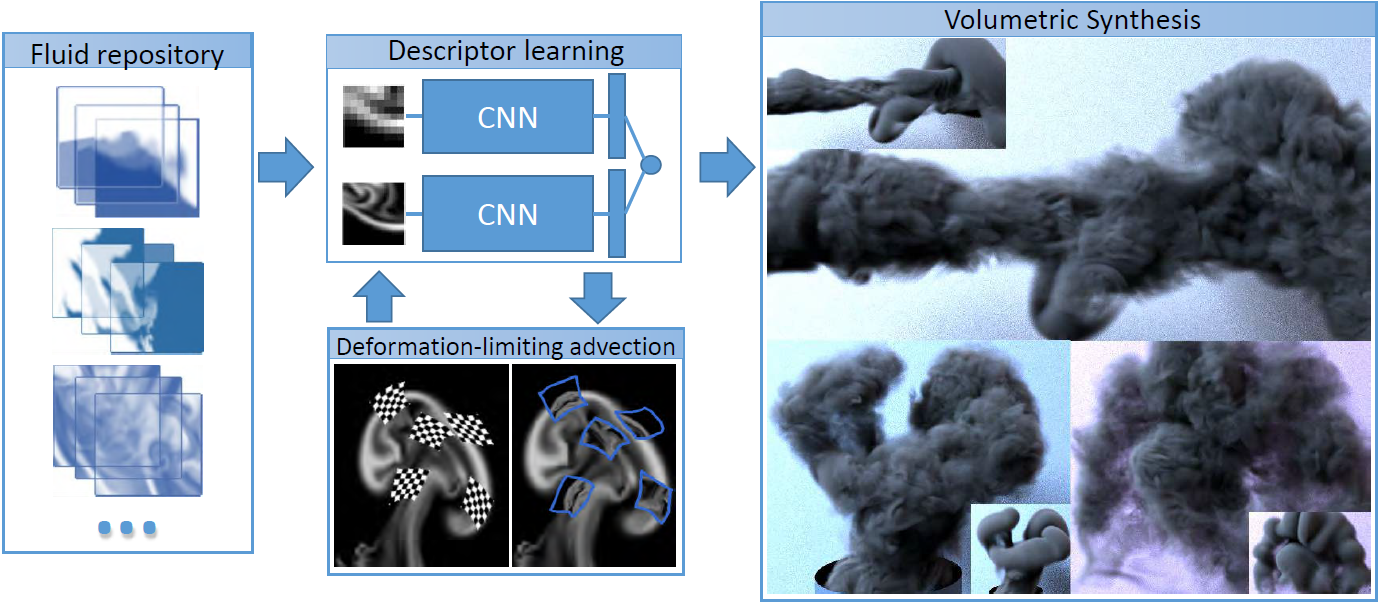ACM Transactions on Graphics (SIGGRAPH 2017), Vol. 36 (4), Article No. 69
Authors
Mengyu Chu, Technical University of Munich
Nils Thuerey, Technical University of Munich
Abstract
We present a novel data-driven algorithm to synthesize high-resolution flow simulations with reusable repositories of space-time flow data. Our approach successfully combines deep learning techniques with flow solvers. In particular, we employ a descriptor learning approach to encode the similarity between fluid regions with differences in resolution and numerical viscosity. We use convolutional neural networks to generate the descriptors from fluid data such as smoke density and flow velocity. At the same time, we present a deformation limiting patch advection method which allows us to robustly track deformable fluid regions. With the help of this patch advection, we generate stable space-time data sets from detailed fluids for our repositories. We can then use our learned descriptors to quickly localize a suitable data set when running a new simulation. This makes our approach very efficient, and resolution independent. We will demonstrate with several examples that our method yields volumes with very high effective resolutions, and non-dissipative small-scale details that naturally integrate into the motions of the underlying flow.
Links
![]() Preprint
Preprint
![]() Presentation
Presentation
![]() Code
Code
![]() Video
Video
![]() DOI
DOI
Further Information
Resolving the vast amount of detail of natural smoke clouds is a long-standing challenge for fluid simulations in computer graphics. Representing this detail typically requires very fine spatial resolutions, which result in costly simulation runs, and in turn cause painfully
long turn-around times.

As shown in the figure, we take a different perspective to efficiently realize high-resolution flows: we propose to use a fluid repository, consisted by a large collection of pre-computed space-time regions. From this, we synthesize new high-resolution volumes. In order to very efficiently find the best match from this repository, we propose to use novel, flow-aware feature descriptor. We will ensure that L2 distances in this feature space will correspond to real matches of flow regions in terms of fluid density as well as fluid motion, so that we can very efficiently retrieve entries even for huge libraries of flow datasets.
In our method, the calculation of descriptors and encoding the effects of discretization errors are handled by a convolutional neural network (CNN). This is the descriptor learning part in the figure. We leverage the regressive capabilities of these CNNs to train networks that learn to encode very small, yet expressive flow descriptors. These descriptors will encode correspondences in the face of numerical approximation errors, and at the same time allow for very efficient retrievals of suitable space-time data-sets from a repository. We compute these correspondences and repository look-ups for localized regions in the flow. We call these regions patches, and we employ a deforming Lagrangian frame to track the patches over time.
The deformation-limiting advection part is also shown in the figure. Compared with recording data from static or rigid regions, this has the advantage that small features are pre-computed and stored in the repository, and do not inadvertently dissipate. In this way, we also side-step the strict time step restrictions that fine spatial discretization usually imposes. On the other hand, we have to make sure the regions do not become too ill-shaped over time. For this, we propose a new deformation-limiting advection scheme with an anticipation step. We match and track each patch independently. This results in a very efficient method, as it allows us to perform all patch-based computations in
parallel.
In combination, our contributions make it possible to very efficiently synthesize highly detailed flow volumes with the help of a re-usable space-time flow repository. More details are written in the paper.
This work was supported by the ERC Starting Grant 637014.

